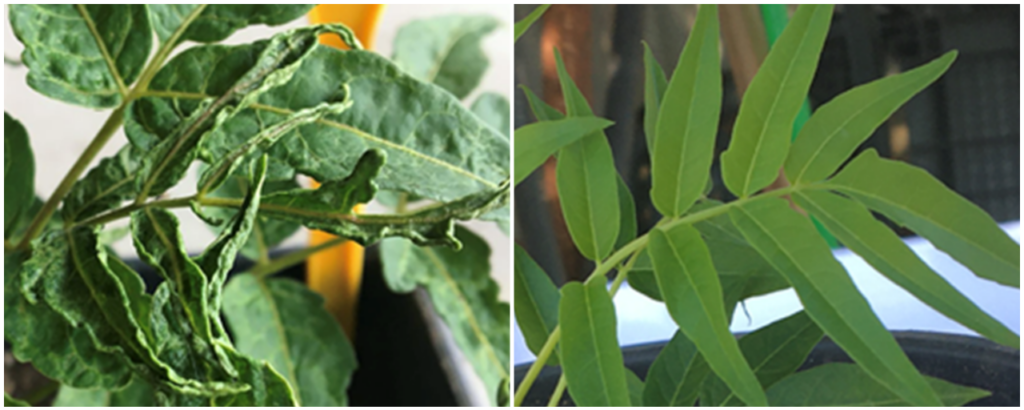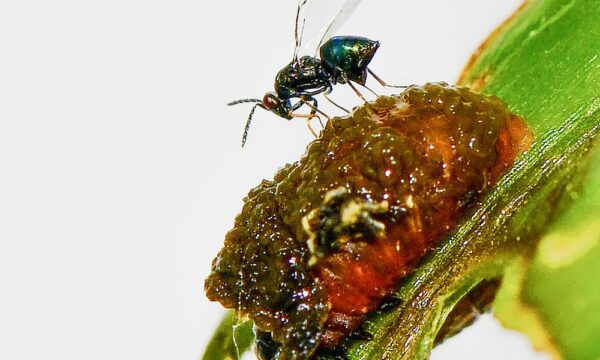
Tree of heaven (Ailanthus altissima) is an invasive, fast-growing deciduous tree native to north-east and central China and Taiwan. It was introduced as an ornamental plant to Europe and North America in the 18th century. It then became invasive and a concern to many countries.
Funded partly by British Columbia Ministry of Forests , CABI has been coordinating options for biological control of tree of heaven in Canada since 2020. Here it is found in British Columbia, Ontario and Quebec.
In Canada, tree of heaven may have a detrimental impact on infrastructure, as it frequently invades forest edges, railways, roads and cracks in pavements. Its roots can also impact other infrastructure, such as building foundations and sewers.
Through allelopathy (the negative effect of one plant species on the development of another), this attractive tree outcompetes native plants that are crucial for a functioning ecosystem and wildlife habitat. Exposure to its pollen, meanwhile, can cause allergic reactions in some people.
The tree – its name referring to its ability to grow very quickly towards the sky – also acts as a haven for several other invasive species. These include the harmful brown marmorated stink bug (Halyomorpha halys), that can wreak havoc on fruit tree and grape crops, and the sap-sucking spotted lanternfly (Lycorma delicatula), a devastating pest to the US wine industry.

Tree of heaven’s saviour mite
Control of tree of heaven is challenging, with mechanical and chemical treatment options limited and expensive. This control can also cause regrowth of sprouts and root suckers. An eriophyid mite initially identified as Aculus mosoniensis, now recognized as Aculus taihangensis, has been prioritized as a potential biological control agent. And it may provide a sustainable alternative solution to controlling this noxious weed.
Originally from China, A. taihangensis has also been found in 13 European countries since 2013. In Europe, the mite was observed forming dense populations on the underside of tree of heaven leaflets (a small leaf attached to a compound leaf). In addition, higher infestations even attached to stems. Feeding causes discolouration and deformation of leaflets and growth points.
Further testing revealed that it can cause severe damage to tree of heaven seedlings. Results suggest that the most likely impact the mite will have is on seedlings and new growth following manual clearing and removal.
This impact is encouraging. New growth from seeds and regrowth from sprouting and root suckering (growths that appear from the root system) is one of the biggest challenges faced when trying to control tree of heaven. If establishment following release of the mite is successful, extensive follow-up treatments with herbicide may no longer be necessary, or greatly reduced.

Future possibilities
Since 2019, the mite was tested by the Biotechnology and Biological Control Agency (BBCA) against 13 plant species in a European context, and only established on tree of heaven.
Not only are these results promising, but they also pave the way for a potential introduction to North America. However, further testing is required before the green light can be given for release in North America. Therefore, a test plant list was created in collaboration with Agriculture and Agri-Food Canada. The mite will need to be evaluated against native species or those of economic value to Canada, before it can be considered for release. These tests are currently ongoing and being conducted by BBCA in Italy.
Should these tests determine that A. taihangensis can safely be released in Canada, it may play a key role in reducing the devastating impact of tree of heaven in North America.
Find out more
Biological control of tree of heaven
Invasive Species Compendium datasheet: Ailanthus altissima (tree of heaven)
Related News & Blogs
Biological control in action: Zambia’s field days on fighting fall armyworm
Experts from CABI recently held two field days and an expo in Zambia, showcasing innovative approaches to pest management to 584 farmers, agro-dealers and other stakeholders to help raise awareness of approaches to tackle the invasive fall armyworm (Sp…
11 June 2025




